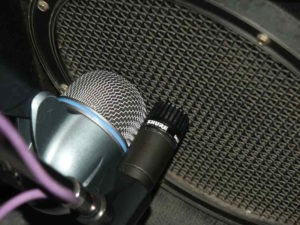- in Book Excerpt , Engineering , Production , Recording by Bobby Owsinski
3 Techniques For Recording Bass Guitar
 Just like the acoustic bass (and just about all instruments), a great bass sound is dependent upon the instrument itself, the player, the amp, and the room. The player has to be able to achieve the tone you’re trying to record with his fingers first and foremost. This excerpt from the 4th edition of my Recording Engineer’s Handbook covers both some considerations and 3 different placement techniques for record this rhythm section staple.
Just like the acoustic bass (and just about all instruments), a great bass sound is dependent upon the instrument itself, the player, the amp, and the room. The player has to be able to achieve the tone you’re trying to record with his fingers first and foremost. This excerpt from the 4th edition of my Recording Engineer’s Handbook covers both some considerations and 3 different placement techniques for record this rhythm section staple.
Considerations
- Although using only a DI can sound good for bass, using an amp (or both together) can really make it easier to dial in a great sound. However, many times the frequency band of the amp can step on the frequency bands of other instruments, such as guitars.
- Always check the phase relationship between the amp and DI to make sure there’s no cancellation of the low end. Flip the polarity switch to the position that has the most bottom.
- If you’re recording into a DAW, align the bass amp track with the DI track so that they are more in phase (you really have to zoom in tight for this.)
There’s no rule that says you have to use both the DI and amp tracks together, so don’t hesitate to use just one of them if it sounds best in the mix.
Placement
Technique #1: The simplest and cleanest way to record an electric bass is with a direct box. Be careful which one you choose, because they’re not all created equally and some will not capture the low fundamental of the bass. Active DIs do a better job of this than passive, although some passive boxes (such as the ones made by Radial) do an excellent job because of the large Jensen transformer used in the circuit.
Technique #2: When miking a bass amp, place a large-diaphragm dynamic, like a D 112, an RE20, or a BETA 52, a little off center and a couple of inches away from the cone of the best-sounding speaker in the bass cabinet (if it has more than one). Depending on the sound that fits the track best, mix with a DI track. The sound will change substantially depending upon the balance between the DI and the miked amplifier.
- Variation: Add an SM57 to the large-diaphragm mic sound for more bite, but be careful not to use too much, or you’ll lose the main body of the sound (see the graphic on the left).
Technique #3: For a metal bass sound, try splitting the bass signal into the normal bass amp and also into a guitar amp that’s set to distort. Make the sound a little dirtier than you feel is appropriate, as it may help it to sit better in the mix. Adjust the EQ of the guitar amp to taste and then add the DI to taste.
For additional miking techniques for the bass as well as just about any other instrument you can think of, check out the Recording Engineer’s Handbook 4th Edition.
You can also read more from The Recording Engineer’s Handbook and my other books on the excerpt section of bobbyowsinski.com.

